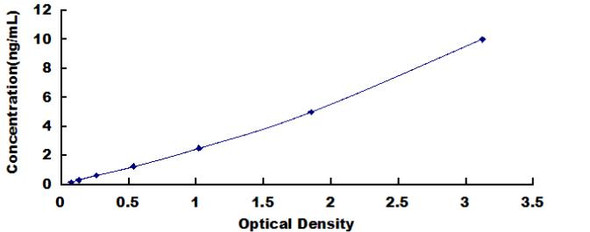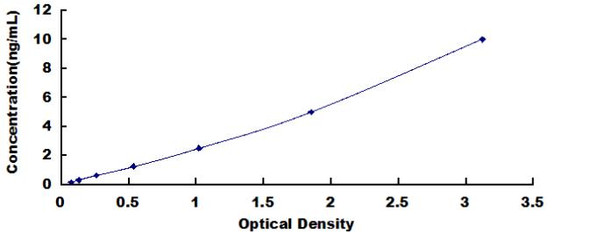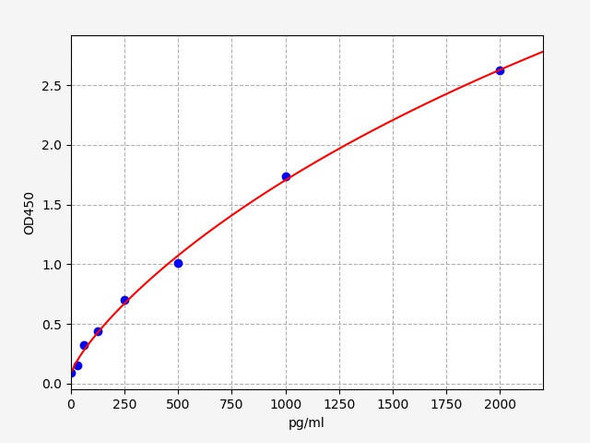Human JNK2 (Mitogen-activated protein kinase 9) ELISA Kit (HUFI03767)
- SKU:
- HUFI03767
- Product Type:
- ELISA Kit
- Size:
- 96 Assays
- Uniprot:
- P45984
- Sensitivity:
- 0.094ng/ml
- Range:
- 0.156-10ng/ml
- ELISA Type:
- Sandwich
- Synonyms:
- c Jun N terminal kinase 2, JNK 55, JNK2, JNK2A, JNK2ALPHA, JNK2B, JNK2BETA, MAP kinase 9, MAPK 9, MAPK9, p54a, p54aSAPK, PRKM9, SAPK
- Reactivity:
- Human
Description
Human JNK2 (Mitogen-activated protein kinase 9) ELISA Kit (HUFI03767)
The Human JNK2 (Mitogen-Activated Protein Kinase 9) ELISA Kit from Assay Genie is a powerful tool for accurately measuring JNK2 levels in human samples. This kit boasts high sensitivity and specificity, guaranteeing precise and consistent results for a variety of research purposes.JNK2, also known as MAPK9, is a key player in the MAPK signaling pathway, regulating processes such as cell proliferation, differentiation, and apoptosis. Dysregulation of JNK2 has been linked to various diseases, including cancer, inflammation, and neurodegenerative disorders, making it a valuable target for therapeutic development.
With the Assay Genie Human JNK2 ELISA Kit, researchers can confidently analyze JNK2 levels in serum, plasma, and cell culture supernatants, paving the way for a deeper understanding of the role of JNK2 in health and disease. Trust Assay Genie for reliable and accurate results in your JNK2 research endeavors.
| Product Name: | Human JNK2 (Mitogen-activated protein kinase 9) ELISA Kit |
| Product Code: | HUFI03767 |
| Size: | 96 Assays |
| Alias: | c Jun N terminal kinase 2 ELISA Kit, JNK 55 ELISA Kit, JNK2 ELISA Kit, JNK2A ELISA Kit, JNK2ALPHA ELISA Kit, JNK2B ELISA Kit, JNK2BETA ELISA Kit, MAP kinase 9 ELISA Kit, MAPK 9 ELISA Kit, MAPK9 ELISA Kit, p54a ELISA Kit, p54aSAPK ELISA Kit, PRKM9 ELISA Kit, SAPK ELISA Kit |
| Detection method: | Sandwich ELISA, Double Antibody |
| Application: | This immunoassay kit allows for the in vitro quantitative determination of Human JNK2 (Mitogen-activated protein kinase 9) concentrations in serum plasma and other biological fluids. |
| Sensitivity: | < 0.094ng/ml |
| Range: | 0.156-10ng/ml |
| Storage: | 4°C for 6 months |
| Note: | For Research Use Only |
| Recovery: | Matrices listed below were spiked with certain level of Human JNK2 (Mitogen-activated protein kinase 9) and the recovery rates were calculated by comparing the measured value to the expected amount of Human JNK2 (Mitogen-activated protein kinase 9) in samples. Enquire for more information. |
| Linearity: | The linearity of the kit was assayed by testing samples spiked with appropriate concentration of Human JNK2 (Mitogen-activated protein kinase 9) and their serial dilutions. The results were demonstrated by the percentage of calculated concentration to the expected. Enquire for more information. |
| CV(%): | Intra-Assay: CV<8% Inter-Assay: CV<10% |
| Component | Quantity | Storage |
| ELISA Microplate (Dismountable) | 8×12 strips | 4°C for 6 months |
| Lyophilized Standard | 2 | 4°C/-20°C |
| Sample/Standard Dilution Buffer | 20ml | 4°C |
| Biotin-labeled Antibody(Concentrated) | 120ul | 4°C (Protect from light) |
| Antibody Dilution Buffer | 10ml | 4°C |
| HRP-Streptavidin Conjugate(SABC) | 120ul | 4°C (Protect from light) |
| SABC Dilution Buffer | 10ml | 4°C |
| TMB Substrate | 10ml | 4°C (Protect from light) |
| Stop Solution | 10ml | 4°C |
| Wash Buffer(25X) | 30ml | 4°C |
| Plate Sealer | 5 | - |
Other materials and equipment required:
- Microplate reader with 450 nm wavelength filter
- Multichannel Pipette, Pipette, microcentrifuge tubes and disposable pipette tips
- Incubator
- Deionized or distilled water
- Absorbent paper
- Buffer resevoir
| UniProt Protein Function: | JNK2: a protein kinase of the MAPK family that is potently activated by a variety of environmental stresses including UV radiation. Phosphorylates specific transcription factors such as c-Jun and ATF2, mediating immediate-early gene expression. Closely related to JNK1. Both are involved in UV radiation induced apoptosis. Blocks the ubiquitination of tumor suppressor p53, and thus it increases the stability of p53 in nonstressed cells. JNK1 and JNK2 are required for polarized differentiation of T-helper cells into Th1 cells in the mouse. Four alternatively-spliced isoforms have been described. |
| UniProt Protein Details: | Protein type:Protein kinase, Ser/Thr (non-receptor); EC 2.7.11.24; Protein kinase, CMGC; Kinase, protein; CMGC group; MAPK family; JNK subfamily; MAPK/JNK subfamily Chromosomal Location of Human Ortholog: 5q35 Cellular Component: nucleoplasm; mitochondrion; cytosol Molecular Function:protein binding; mitogen-activated protein kinase kinase kinase binding; caspase activator activity; JUN kinase activity; transcription factor binding; ATP binding Biological Process: central nervous system development; positive regulation of nitric oxide biosynthetic process; regulation of protein ubiquitination; response to toxin; positive regulation of transcription, DNA-dependent; stress-activated MAPK cascade; rhythmic process; toll-like receptor 3 signaling pathway; protein amino acid phosphorylation; regulation of JNK cascade; toll-like receptor 10 signaling pathway; toll-like receptor 5 signaling pathway; regulation of transcription factor activity; response to stress; JNK cascade; protein targeting to mitochondrion; toll-like receptor 4 signaling pathway; neurite development; positive regulation of prostaglandin biosynthetic process; caspase activation; response to drug; release of cytochrome c from mitochondria; MyD88-independent toll-like receptor signaling pathway; regulation of circadian rhythm; positive regulation of chemokine production; toll-like receptor 2 signaling pathway; JUN phosphorylation; MyD88-dependent toll-like receptor signaling pathway; response to cadmium ion; response to mechanical stimulus; positive regulation of prostaglandin secretion; toll-like receptor signaling pathway; innate immune response; toll-like receptor 9 signaling pathway; positive regulation of protein amino acid phosphorylation; response to amine stimulus; positive regulation of nitric-oxide synthase biosynthetic process |
| NCBI Summary: | The protein encoded by this gene is a member of the MAP kinase family. MAP kinases act as an integration point for multiple biochemical signals, and are involved in a wide variety of cellular processes such as proliferation, differentiation, transcription regulation and development. This kinase targets specific transcription factors, and thus mediates immediate-early gene expression in response to various cell stimuli. It is most closely related to MAPK8, both of which are involved in UV radiation induced apoptosis, thought to be related to the cytochrome c-mediated cell death pathway. This gene and MAPK8 are also known as c-Jun N-terminal kinases. This kinase blocks the ubiquitination of tumor suppressor p53, and thus it increases the stability of p53 in nonstressed cells. Studies of this gene's mouse counterpart suggest a key role in T-cell differentiation. Several alternatively spliced transcript variants encoding distinct isoforms have been reported. [provided by RefSeq, Sep 2008] |
| UniProt Code: | P45984 |
| NCBI GenInfo Identifier: | 85700366 |
| NCBI Gene ID: | 5601 |
| NCBI Accession: | P45984.2 |
| UniProt Secondary Accession: | P45984,Q15708, Q15710, Q15711, Q8N5C5, A8K0S3, B5BU66 B5M0B4, D3DWQ8, D3DWQ9, |
| UniProt Related Accession: | P45984 |
| Molecular Weight: | 27,334 Da |
| NCBI Full Name: | Mitogen-activated protein kinase 9 |
| NCBI Synonym Full Names: | mitogen-activated protein kinase 9 |
| NCBI Official Symbol: | MAPK9 |
| NCBI Official Synonym Symbols: | JNK2; SAPK; p54a; JNK2A; JNK2B; PRKM9; JNK-55; SAPK1a; JNK2BETA; p54aSAPK; JNK2ALPHA |
| NCBI Protein Information: | mitogen-activated protein kinase 9; MAPK 9; Jun kinase; MAP kinase 9; c-Jun kinase 2; c-Jun N-terminal kinase 2; stress-activated protein kinase 1a; stress-activated protein kinase JNK2 |
| UniProt Protein Name: | Mitogen-activated protein kinase 9 |
| UniProt Synonym Protein Names: | JNK-55; Stress-activated protein kinase 1a; SAPK1a; Stress-activated protein kinase JNK2; c-Jun N-terminal kinase 2 |
| UniProt Gene Name: | MAPK9 |
| UniProt Entry Name: | MK09_HUMAN |
*Note: Protocols are specific to each batch/lot. For the correct instructions please follow the protocol included in your kit.
Before adding to wells, equilibrate the SABC working solution and TMB substrate for at least 30 min at 37 °C. When diluting samples and reagents, they must be mixed completely and evenly. It is recommended to plot a standard curve for each test.
| Step | Protocol |
| 1. | Set standard, test sample and control (zero) wells on the pre-coated plate respectively, and then, record their positions. It is recommended to measure each standard and sample in duplicate. Wash plate 2 times before adding standard, sample and control (zero) wells! |
| 2. | Aliquot 0.1ml standard solutions into the standard wells. |
| 3. | Add 0.1 ml of Sample / Standard dilution buffer into the control (zero) well. |
| 4. | Add 0.1 ml of properly diluted sample ( Human serum, plasma, tissue homogenates and other biological fluids.) into test sample wells. |
| 5. | Seal the plate with a cover and incubate at 37 °C for 90 min. |
| 6. | Remove the cover and discard the plate content, clap the plate on the absorbent filter papers or other absorbent material. Do NOT let the wells completely dry at any time. Wash plate X2. |
| 7. | Add 0.1 ml of Biotin- detection antibody working solution into the above wells (standard, test sample & zero wells). Add the solution at the bottom of each well without touching the side wall. |
| 8. | Seal the plate with a cover and incubate at 37 °C for 60 min. |
| 9. | Remove the cover, and wash plate 3 times with Wash buffer. Let wash buffer rest in wells for 1 min between each wash. |
| 10. | Add 0.1 ml of SABC working solution into each well, cover the plate and incubate at 37 °C for 30 min. |
| 11. | Remove the cover and wash plate 5 times with Wash buffer, and each time let the wash buffer stay in the wells for 1-2 min. |
| 12. | Add 90 µL of TMB substrate into each well, cover the plate and incubate at 37 °C in dark within 10-20 min. (Note: This incubation time is for reference use only, the optimal time should be determined by end user.) And the shades of blue can be seen in the first 3-4 wells (with most concentrated standard solutions), the other wells show no obvious color. |
| 13. | Add 50 µL of Stop solution into each well and mix thoroughly. The color changes into yellow immediately. |
| 14. | Read the O.D. absorbance at 450 nm in a microplate reader immediately after adding the stop solution. |
When carrying out an ELISA assay it is important to prepare your samples in order to achieve the best possible results. Below we have a list of procedures for the preparation of samples for different sample types.
| Sample Type | Protocol |
| Serum | If using serum separator tubes, allow samples to clot for 30 minutes at room temperature. Centrifuge for 10 minutes at 1,000x g. Collect the serum fraction and assay promptly or aliquot and store the samples at -80°C. Avoid multiple freeze-thaw cycles. If serum separator tubes are not being used, allow samples to clot overnight at 2-8°C. Centrifuge for 10 minutes at 1,000x g. Remove serum and assay promptly or aliquot and store the samples at -80°C. Avoid multiple freeze-thaw cycles. |
| Plasma | Collect plasma using EDTA or heparin as an anticoagulant. Centrifuge samples at 4°C for 15 mins at 1000 × g within 30 mins of collection. Collect the plasma fraction and assay promptly or aliquot and store the samples at -80°C. Avoid multiple freeze-thaw cycles. Note: Over haemolysed samples are not suitable for use with this kit. |
| Urine & Cerebrospinal Fluid | Collect the urine (mid-stream) in a sterile container, centrifuge for 20 mins at 2000-3000 rpm. Remove supernatant and assay immediately. If any precipitation is detected, repeat the centrifugation step. A similar protocol can be used for cerebrospinal fluid. |
| Cell culture supernatant | Collect the cell culture media by pipette, followed by centrifugation at 4°C for 20 mins at 1500 rpm. Collect the clear supernatant and assay immediately. |
| Cell lysates | Solubilize cells in lysis buffer and allow to sit on ice for 30 minutes. Centrifuge tubes at 14,000 x g for 5 minutes to remove insoluble material. Aliquot the supernatant into a new tube and discard the remaining whole cell extract. Quantify total protein concentration using a total protein assay. Assay immediately or aliquot and store at ≤ -20 °C. |
| Tissue homogenates | The preparation of tissue homogenates will vary depending upon tissue type. Rinse tissue with 1X PBS to remove excess blood & homogenize in 20ml of 1X PBS (including protease inhibitors) and store overnight at ≤ -20°C. Two freeze-thaw cycles are required to break the cell membranes. To further disrupt the cell membranes you can sonicate the samples. Centrifuge homogenates for 5 mins at 5000xg. Remove the supernatant and assay immediately or aliquot and store at -20°C or -80°C. |
| Tissue lysates | Rinse tissue with PBS, cut into 1-2 mm pieces, and homogenize with a tissue homogenizer in PBS. Add an equal volume of RIPA buffer containing protease inhibitors and lyse tissues at room temperature for 30 minutes with gentle agitation. Centrifuge to remove debris. Quantify total protein concentration using a total protein assay. Assay immediately or aliquot and store at ≤ -20 °C. |
| Breast Milk | Collect milk samples and centrifuge at 10,000 x g for 60 min at 4°C. Aliquot the supernatant and assay. For long term use, store samples at -80°C. Minimize freeze/thaw cycles. |










